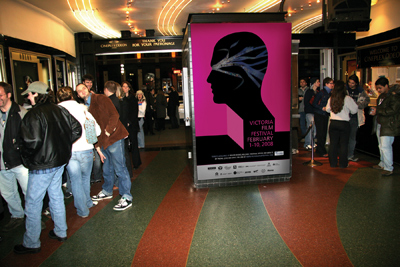|
Interactive Futures
Interactive Futures (IF) was a wikt:Special:Search/biennial, biennial conference and exhibition, hosted in Vancouver, British Columbia, Canada, that explored current tendencies, research and dialogue related to the intersection of technology and art. Interactive Futures included a variety of events such as lectures, workshops, exhibitions, and panels in an effort to provide opportunities for discourse by local, national and international researchers and practitioners. History Interactive Futures (IF) has been active since 2002 holding a conference alongside its exhibitions and performances. From 2002 through 2007, Interactive Futures has grown from a single venue event, held at the University of Victoria that featured local researchers and artists, to a multi-venue event with international cultural partners, aactive archival websiteand international publications. For IF'09, Julie Andreyev and Maria Lantin became co-Directors and relocated IF to Intersections Digital Studios, Emily C ... [...More Info...] [...Related Items...] OR: [Wikipedia] [Google] [Baidu] |
Marc Bekoff
Marc Bekoff (born September 6, 1945 in Brooklyn, NY) is an American biologist, ethologist, behavioural ecologist and writer. He was a professor of Ecology and Evolutionary Biology at the University of Colorado Boulder for 32 years. He cofounded the Jane Goodall Institute of Ethologists for the Ethical Treatment of Animals, and he is Professor Emeritus of Ecology and Evolutionary Biology at the University of Colorado Boulder. Education and academic career Bekoff earned a Bachelor of Arts degree from Washington University in 1967, a Master of Arts from Hofstra University in 1968, and a Ph.D. in Animal Behavior from Washington University in 1972. After completing his Ph.D., he became an assistant professor of biology at University of Missouri–St. Louis in 1973 through 1974. He went on to work at the University of Colorado Boulder as the professor of organismic biology where he pursues research into ethology, animal behavior, behavioral ecology, development and evolution of behav ... [...More Info...] [...Related Items...] OR: [Wikipedia] [Google] [Baidu] |
Canadian Council For The Arts
The Canada Council for the Arts (french: Conseil des arts du Canada), commonly called the Canada Council, is a Crown corporation established in 1957 as an arts council of the Government of Canada. It acts as the federal government's principal instrument for funding public arts, as well as for fostering and promoting the study and enjoyment of, and the production of works in, the arts. The Canada Council fulfills its mandate primarily through providing grants and services to professional Canadian artists and arts organizations in dance, interdisciplinary art, media arts, music, opera, theatre, writing, publishing, and the visual arts. In addition, the Canada Council administers the Art Bank, which operates art rental programs and an exhibitions and outreach program. The Canada Council Art Bank holds the largest collection of contemporary Canadian art in the world. The Canada Council is also responsible for the secretariat for the Canadian Commission for UNESCO and the P ... [...More Info...] [...Related Items...] OR: [Wikipedia] [Google] [Baidu] |
Victoria Film Festival
The Victoria Film Festival is a publicly attended film festival in Victoria, British Columbia, Canada running for ten days in February. The festival shows both Canadian and international films and unreels 150 films with 55 Features on 6 screens around Victoria. It attracts a continually growing audience, reaching 24,000 in 2011. The festival began in 1995 and is a provincially registered non-profit and federally registered charitable organization. AMPLIFY: Festival Special Events Opening Gala All-inclusive night of frivolity. In Conversation With... Join us for an engaging and lively night of conversation with a great actor. SpringBoard: Industry Event An event for people interested in creating films. Sessions include Collaborating with Finances, pitching buyers and producers and a networking reception. VIFPA: Victoria Film Producers' Night Enjoy a peek at what local filmmakers have been creating. Sips n' Cinema This is a social event for those who would like to take a deepe ... [...More Info...] [...Related Items...] OR: [Wikipedia] [Google] [Baidu] |
Animator
An animator is an artist who creates multiple images, known as frames, which give an illusion of movement called animation when displayed in rapid sequence. Animators can work in a variety of fields including film, television, and video games. Animation is closely related to filmmaking and like filmmaking is extremely labor-intensive, which means that most significant works require the collaboration of several animators. The methods of creating the images or frames for an animation piece depend on the animators' artistic styles and their field. Other artists who contribute to animated cartoons, but who are not animators, include layout artists (who design the backgrounds, lighting, and camera angles), storyboard artists (who draw panels of the action from the script), and background artists (who paint the "scenery"). Animated films share some film crew positions with regular live action films, such as director, producer, sound engineer, and editor, but differ radically ... [...More Info...] [...Related Items...] OR: [Wikipedia] [Google] [Baidu] |
Film Director
A film director controls a film's artistic and dramatic aspects and visualizes the screenplay (or script) while guiding the film crew and actors in the fulfilment of that vision. The director has a key role in choosing the cast members, production design and all the creative aspects of filmmaking. The film director gives direction to the cast and crew and creates an overall vision through which a film eventually becomes realized or noticed. Directors need to be able to mediate differences in creative visions and stay within the budget. There are many pathways to becoming a film director. Some film directors started as screenwriters, cinematographers, producers, film editors or actors. Other film directors have attended a film school. Directors use different approaches. Some outline a general plotline and let the actors improvise dialogue, while others control every aspect and demand that the actors and crew follow instructions precisely. Some directors also write thei ... [...More Info...] [...Related Items...] OR: [Wikipedia] [Google] [Baidu] |
San Francisco State University
San Francisco State University (commonly referred to as San Francisco State, SF State and SFSU) is a public research university in San Francisco. As part of the 23-campus California State University system, the university offers 118 different bachelor's degrees, 94 master's degrees, and 5 doctoral degrees along with 26 teaching credentials among six academic colleges.SF State Facts 2009–2010 San Francisco State University It is classified among "R2: Doctoral Universities – High research activity". The university was founded in 1899 as a state-run |
George Legrady
George Legrady (''Légrády György, Tamás, Antal, Tivadar'', born January 8, 1950) is a multidisciplinary digital media artist and university professor in photography and computational media arts. Early life and education Legrady was born in Budapest, Hungary, and emigrated to Montreal, Quebec, Canada at age 6 with his parents and brothers Miklos and Thomas under political refugee status in November 1956 during the Hungarian Revolution. His father, :nl:Thomas Legrady was a musician and composer. His paternal great-grandfather Légrády Tivadar was a lithographer and co-founder with his brother :hu:Légrády Károly, of the Légrády Testvérek publishing house in Budapest. His maternal great-grandfather, :hu:Váradi Antal, was a playwright, poet, and director of the Hungarian National Academy of Dramatic Arts in Budapest. Legrady attended French elementary school in Montreal at pensionnat Mont Jésus-Marie, Outremont with his brother Miklos, where both studied classical musi ... [...More Info...] [...Related Items...] OR: [Wikipedia] [Google] [Baidu] |
Sensory Illusions
An illusion is a distortion of the senses, which can reveal how the mind normally organizes and interprets sensory stimulation. Although illusions distort the human perception of reality, they are generally shared by most people. Illusions may occur with any of the human senses, but visual illusions (optical illusions) are the best-known and understood. The emphasis on visual illusions occurs because vision often dominates the other senses. For example, individuals watching a ventriloquist will perceive the voice is coming from the dummy since they are able to see the dummy mouth the words. Some illusions are based on general assumptions the brain makes during perception. These assumptions are made using organizational principles (e.g., Gestalt theory), an individual's capacity for depth perception and motion perception, and perceptual constancy. Other illusions occur because of biological sensory structures within the human body or conditions outside the body within one's p ... [...More Info...] [...Related Items...] OR: [Wikipedia] [Google] [Baidu] |
Stereoscopy
Stereoscopy (also called stereoscopics, or stereo imaging) is a technique for creating or enhancing the illusion of depth in an image by means of stereopsis for binocular vision. The word ''stereoscopy'' derives . Any stereoscopic image is called a stereogram. Originally, stereogram referred to a pair of stereo images which could be viewed using a stereoscope. Most stereoscopic methods present a pair of two-dimensional images to the viewer. The left image is presented to the left eye and the right image is presented to the right eye. When viewed, the human brain perceives the images as a single 3D view, giving the viewer the perception of 3D depth. However, the 3D effect lacks proper focal depth, which gives rise to the Vergence-Accommodation Conflict. Stereoscopy is distinguished from other types of 3D displays that display an image in three full dimensions, allowing the observer to increase information about the 3-dimensional objects being displayed by head and eye mov ... [...More Info...] [...Related Items...] OR: [Wikipedia] [Google] [Baidu] |
Stereographic 3D
Stereoscopy (also called stereoscopics, or stereo imaging) is a technique for creating or enhancing the illusion of depth in an image by means of stereopsis for binocular vision. The word ''stereoscopy'' derives . Any stereoscopic image is called a stereogram. Originally, stereogram referred to a pair of stereo images which could be viewed using a stereoscope. Most stereoscopic methods present a pair of two-dimensional images to the viewer. The left image is presented to the left eye and the right image is presented to the right eye. When viewed, the human brain perceives the images as a single 3D view, giving the viewer the perception of 3D depth. However, the 3D effect lacks proper focal depth, which gives rise to the Vergence-Accommodation Conflict. Stereoscopy is distinguished from other types of 3D displays that display an image in three full dimensions, allowing the observer to increase information about the 3-dimensional objects being displayed by head and eye ... [...More Info...] [...Related Items...] OR: [Wikipedia] [Google] [Baidu] |
Stereophonic Sound
Stereophonic sound, or more commonly stereo, is a method of sound reproduction that recreates a multi-directional, 3-dimensional audible perspective. This is usually achieved by using two independent audio channels through a configuration of two loudspeakers (or stereo headphones) in such a way as to create the impression of sound heard from various directions, as in natural hearing. Because the multi-dimensional perspective is the crucial aspect, the term ''stereophonic'' also applies to systems with more than two channels or speakers such as quadraphonic and surround sound. Binaural recording, Binaural sound systems are also ''stereophonic''. Stereo sound has been in common use since the 1970s in entertainment media such as broadcast radio, recorded music, television, video cameras, cinema, computer audio, and internet. Etymology The word ''stereophonic'' derives from the Greek language, Greek (''stereós'', "firm, solid") + (''phōnḗ'', "sound, tone, voice") and i ... [...More Info...] [...Related Items...] OR: [Wikipedia] [Google] [Baidu] |






